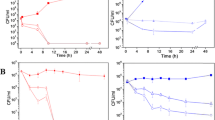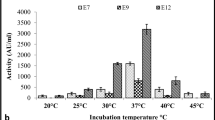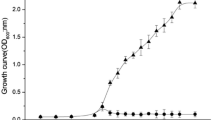Abstract
Food borne diseases have a major impact on public health whose epidemiology is rapidly changing. The whole cells of pathogens involved or their toxins/metabolites affect the human health apart from spoiling sensory properties of the food products finally affecting the food industry as well as consumer health. With pathogens developing mechanisms of antibiotic resistance, there has been an increased need to replace antibiotics as well as chemical additives with naturally occurring bacteriocins. Bacteriocins are known to act mainly against Gram-positive pathogens and with little or no effect towards Gram-negative enteric bacteria. In the present study, combination effect of lipase and bacteriocin produced by Enterococcus faecium NCIM5363, a highly lipolytic lactic acid bacterium against various food pathogens was assessed. The lipase in combination with enterocin exhibited a lethal effect against Gram-negative pathogens. Scanning electron microscopy studies carried out to ascertain the constitutive mode of action of lipase and enterocin revealed that the lipase degrades the cell wall of Gram-negative bacteria and creates a pore through which enterocin enters thereby resulting in cell death. The novelty of this work is the fact that this is the first report revealing the synergistic effect of lipase with enterocin against Gram-negative bacteria.





Similar content being viewed by others
References
Aarestrup FM (2000) Occurrence, selection and spread of resistance to antimicrobial agents used for growth promotion for food animals in Denmark. APMIS 108:1–48
Alcaine SD, Sukhnanand SS, Warnick LD, Su WL, McGann P, McDonough P, Weidmann M (2005) Cetiofur-resistant Salmonella strains isolated from dairy farms represent multiple widely distributed subtypes that evolved by independent horizontal gene transfer. Antimicrob Agents Chemother 49:4061–4067
Balakrishnan P, Thamaraichelvan R, Ereelot N, Dhannya GS, Chidambaram KV (2011) Production of lipase enzyme from Lactobacillus spp. and its application in the degradation of meat. World Appl Sci J 12(10):1798–1802
Bierbaum G, Sahl HG (1991) Induction of autolysis of Staphylococcus simulans 22 by Pep5 and nisin and influence of the cationic peptides on the activity of the autolytic enzymes. In: Jung G, Sahl HG (eds) Nisin and novel lantibiotics. Escom Publishers, Leiden
Burianek LL, Yousef AE (2000) Solvent extraction of bacteriocins from liquid cultures. Lett Appl Microbiol 31:193–197
Costerton JW, Ingram JM, Cheng KJ (1974) Structure and function of the cell envelope of Gram-negative bacteria. Bacteriol Rev 38:87–110
Geis A, Singh J, Teuber M (1983) Potential of lactic Streptococcus to produce bacteriocin. Appl Environ Microbiol 51:105–109
Kloos WE, Bannerman TL (1994) Update on clinical significance of coagulase-negative staphylococci. Clin Microbiol Rev 7:117–140
Leive L (1968) Studies on the permeability change produced in coliform bacteria by ethylenediaminetetraacetate. J Biol Chem 243:2372–2380
Leroy F, Moreno MRF, De Vuyst L (2003) Enterococcus faecium RZS C5, an interesting bacteriocin producer to be used as a co-culture in food fermentation. Int J Food Microbiol 88:235–240
McDougall LA, Holzapfel WH, Schillinger U, Feely DE, Rupnow JH (1994) Scanning electron microscopy of target cells and molecular weight determination of a bacteriocin produced by Lactococcus lactis D53. Int J Food Microbiol 24:295–308
Noris M, Remuzzi G (2005) Haemolytic uremic syndrome. J Am Soc Nephrol 16:1035–1050
Sahl HG, Brandis H (1983) Efflux of low Mr substances from the cytoplasm of sensitive cells caused by staphylococcin like agent Pep5. FEMS Microbiol Lett 16:75–79
Sahl HG, Hahn C, Brandis H (1985) Interaction of the staphylococcin like peptide Pep5 with cell walls and isolated cell wall components of gram-positive bacteria. Zentralbl.Bakteriol.Mikrobiol.Hyg. I Abt Orig.A 260:197–205
Schuchat A, Swaminathan B, Broome CV (1991) Epidemiology of human listeriosis. Clin Microbiol Rev 4:69–83
Stiles ME, Hastings JW (1991) Bacteriocin production by lactic acid bacteria: potential for use in meat preservation. Trends Food Sci Technol 2:247–251
Sutcliffe IC, Russel RRB (1995) Lipoproteins of Gram-positive bacteria. J Bacteriol 177:1123–1128
Yamada KY, Ota H, Machinda H (1962) A modified method for lipase activity assay with emulsified olive oil as substrate. Nippon Nogeikagaku Kaishi 36:860
Acknowledgments
Authors thank their parent organization Council of Scientific and Industrial Research (CSIR) for funding this work through Encouraging & Motivating World class Exploratory Research (EMPOWER) scheme to NB. VR thanks University Grants Commission (UGC), Govt. of India for the senior research fellowship. Authors place on record their thanks to Director, CFTRI for encouragement and permission to publish the work.
Author information
Authors and Affiliations
Corresponding author
Rights and permissions
About this article
Cite this article
Ramakrishnan, V., Narayan, B. & Halami, P.M. Combined Effect of Enterocin and Lipase From Enterococcus faecium NCIM5363 Against Food Borne Pathogens: Mode of Action Studies. Curr Microbiol 65, 162–169 (2012). https://doi.org/10.1007/s00284-012-0138-z
Received:
Accepted:
Published:
Issue Date:
DOI: https://doi.org/10.1007/s00284-012-0138-z




